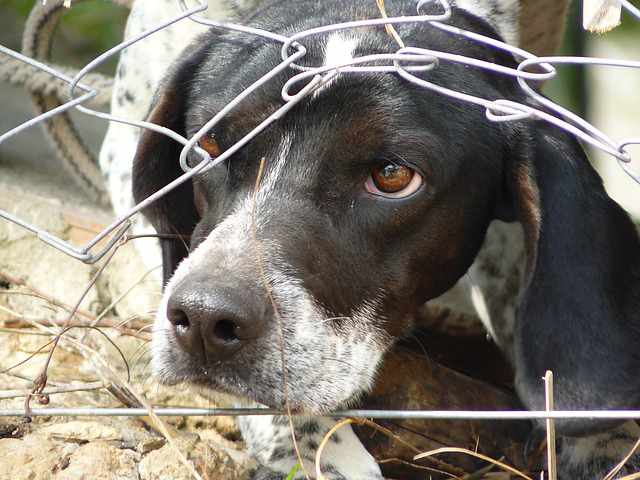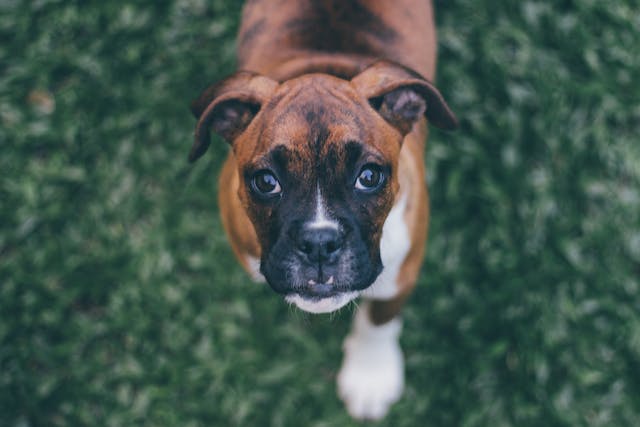Today, we’re diving into the fascinating world of dogs and understanding fear aggression in dogs.
Join me as we unravel the mysteries behind why some dogs exhibit aggression when they’re afraid, and discover practical tips to help our four-legged friends overcome their fears and live their happiest, tail-wagging lives.
So, grab a cup of coffee, sit back, and let’s embark on this enlightening journey together!
What is fear aggression in dogs?
Fear aggression in dogs refers to aggressive behavior displayed by a dog when it is afraid or feels threatened.
This type of aggression is a defensive response and is often characterized by growling, barking, lunging, or biting.
Fear aggression can be triggered by various factors, such as past traumatic experiences, lack of socialization, or genetic predisposition.
It is important to address fear aggression in dogs through proper training, behavior modification techniques, and, in some cases, professional help from a veterinarian or animal behaviorist.
Effects of Fear Aggression on Dogs
Fear aggression in dogs can have significant effects on their behavior and well-being.
Firstly, fear aggression can lead to increased reactivity towards perceived threats, causing the dog to display aggressive behaviors such as growling, snapping, or biting.
Secondly, fear aggression can result in heightened anxiety and increased stress levels, leading to a decreased quality of life for the dog.
Thirdly, fear aggression can make it challenging for the dog to interact with other animals or people, potentially limiting their socialization opportunities.
Additionally, fear aggression can negatively impact the human-dog bond, as owners may feel unsafe or fearful around their aggressive dog.
Finally, fear aggression can have legal implications, as aggressive behavior can result in injury or damage, potentially leading to consequences for the dog and its owner.
Causes of Fear Aggression in Dogs

Fear aggression in dogs can manifest as aggressive behavior when the dog feels threatened or afraid. There are several common causes of fear aggression in dogs.
Here are some major causes:
1. Lack of Socialization: Insufficient or improper socialization during a dog’s critical developmental period can lead to fear-based aggression later in life. Dogs that haven’t been exposed to various people, animals, and environments may become fearful and react aggressively when faced with unfamiliar situations.
2. Traumatic Experiences: Dogs that have experienced traumatic events such as abuse, neglect, or physical attacks from other animals may develop fear aggression as a defense mechanism. These negative experiences can create lasting fear and anxiety, causing the dog to react aggressively when they feel threatened.
3. Genetic Factors: Some dogs may have a genetic predisposition for fearfulness or anxiety, which can contribute to fear aggression. Certain breeds may be more prone to fear-based behaviors due to their breeding history or genetic traits.
4. Lack of Confidence: Dogs with low self-confidence are more likely to exhibit fear aggression. When a dog feels insecure or unsure of themselves, they may resort to aggression as a way to protect themselves or establish control over a situation.
5. Resource Guarding: Fear aggression can also arise when a dog is possessive or protective of their resources, such as food, toys, or territory. The fear of losing these valuable possessions can trigger aggressive behaviors as a defensive response.
6. Medical Issues: Underlying medical conditions or pain can cause fear aggression in dogs. If a dog is in pain or discomfort, they may become more reactive and aggressive when approached or touched.
7. Fear of Punishment: Dogs that have been subjected to harsh or punitive training methods may develop fear aggression. If a dog associates certain actions or situations with punishment or pain, they may become fearful and exhibit aggressive behavior as a defensive response.
Read more about the causes of aggression in dogs.
Signs of Fear Aggression in Dogs

Fear aggression in dogs can manifest through various signs. One common sign is growling or snarling, where the dog displays a low, rumbling vocalization.
Dogs may also show defensive body language, such as a tucked tail, flattened ears, and a stiff posture. They may try to make themselves appear larger by raising their hackles or standing on their tiptoes.
Another indicator is avoidance behavior, where the dog tries to retreat or hide from the perceived threat. Some dogs may escalate their aggression by barking, lunging, or even biting when they feel threatened.
It’s important to recognize these signs and seek professional help to address fear aggression in dogs for the safety of both the dog and those around them.
Read more about the warning signs of dog aggression.
Managing Fear Aggression in Dogs
Managing fear aggression in dogs requires a comprehensive approach that addresses the underlying causes of fear and employs effective techniques to modify the dog’s behavior.
Here are some recommended strategies for managing fear aggression in dogs:
1. Positive Reinforcement Training: Positive reinforcement training techniques focus on rewarding desired behaviors, which can help build the dog’s confidence and create positive associations with previously feared situations or triggers. Rewarding calm and non-aggressive behaviors promotes a more relaxed state of mind and can gradually reduce fear aggression.
2. Counterconditioning and Desensitization: This technique involves gradually exposing the dog to fear-inducing stimuli or situations at a low intensity while providing positive reinforcement. By gradually increasing exposure and associating it with positive experiences, the dog can learn to feel more comfortable and less fearful. It’s essential to proceed at the dog’s pace and avoid overwhelming them, as this could worsen their fear response.
3. Environmental Management: Creating a safe and secure environment for the dog can help reduce fear and anxiety triggers. This includes providing a designated retreat area or safe space where the dog can retreat when feeling anxious or threatened. Minimizing exposure to known triggers and gradually introducing them in a controlled manner can also be helpful.
4. Consistency and Predictability: Fearful dogs benefit from a structured routine and predictable environment. Maintaining a consistent schedule for meals, exercise, and training sessions can help reduce anxiety and provide a sense of security. Additionally, using consistent commands and cues during training helps the dog understand what is expected of them, reducing confusion and potential triggers for fear aggression.
5. Avoid Punishment and Negative Reinforcement: Punishment or negative reinforcement can exacerbate fear aggression in dogs. It can increase anxiety and lead to defensive or aggressive responses. Instead, focus on positive reinforcement and reward-based training to build trust and confidence.
6. Seek Professional Help: Dealing with fear aggression can be challenging, and it’s often beneficial to consult with a professional dog trainer or behaviorist experienced in working with fearful dogs. They can assess the dog’s behavior, develop a tailored behavior modification plan, and guide you through the training process. They may also provide additional techniques, such as using calming aids or implementing specific management strategies, depending on the individual dog’s needs.
Remember that managing fear aggression in dogs requires patience, consistency, and understanding. It’s crucial to approach the training process with empathy and avoid punishment-based methods, as these can worsen fear and aggression.
With the right approach and professional guidance, many dogs can make significant progress in overcoming fear aggression and lead happier, more confident lives.
Read more about how to calm an aggressive dog.
How to Prevent Fear Aggression in Dogs

To prevent fear aggression in dogs, it is crucial to focus on early socialization and positive experiences. Exposing puppies to various people, animals, and environments helps them develop confidence and reduces the likelihood of fear-based aggression later in life.
Consistent and positive training methods, such as reward-based training, can also help build trust and decrease anxiety. Identifying and removing triggers that cause fear or anxiety in the dog’s environment is essential.
Seeking professional help from a certified dog trainer or behaviorist can provide valuable guidance in addressing fear aggression effectively.
Regular exercise, mental stimulation, and a stable, structured routine can contribute to overall well-being and help reduce fear and anxiety in dogs.
Read more about preventing aggression in dogs.
How I Helped My Dog (Jackie) With a Fear-Based Aggression
My dog (Jackie) is a female German Shepherd who is a rescue dog that suffered from fear aggression towards strangers.
Her previous experiences had left her anxious and reactive, making it challenging for her to interact with unfamiliar people.
To help Jackie overcome her fear-based aggression, I implemented a systematic desensitization and counter-conditioning program.
I gradually exposed Jackie to strangers in controlled environments, using positive reinforcement techniques to associate strangers with rewards and positive experiences.
I also sought the help of a professional dog trainer who provided guidance and support throughout the process.
With consistent training, patience, and love, Jackie’s fear aggression gradually diminished, and she became more comfortable around strangers.
Today, Jackie enjoys meeting new people and has developed a newfound confidence, showcasing the power of effective behavior management in helping dogs overcome fear aggression.
Frequently Asked Questions
What exactly is fear aggression in dogs?
Fear aggression refers to a defensive behavior displayed by dogs when they feel threatened or scared. It’s their way of trying to protect themselves from perceived dangers.
What are some common signs of fear aggression in dogs?
Dogs experiencing fear aggression may exhibit behaviors like growling, barking, snapping, or even lunging towards perceived threats. They may also display signs of anxiety, such as trembling or cowering.
What can cause fear aggression in dogs?
Fear aggression can stem from various factors, including past traumatic experiences, lack of socialization, genetic predisposition, or even a lack of confidence. Identifying the underlying cause is crucial to addressing the issue effectively.
How can I help my dog overcome fear aggression?
Patience and positive reinforcement are key. Gradual desensitization and counterconditioning techniques, along with professional guidance, can help your dog build confidence and learn to cope with their fears in a positive way.
Should I punish my dog for displaying fear aggression?
No, punishment can worsen fear aggression and escalate the situation. It’s essential to understand that fear aggression is not a deliberate act of defiance but a response to fear. Instead, focus on creating a safe and supportive environment for your furry friend.
Can fear aggression be completely eliminated in dogs?
While fear aggression can be managed and improved, complete elimination may not always be possible. The goal is to help your dog feel more secure, reduce their fear responses, and teach them alternative behaviors to cope with challenging situations.
Read more about the types of aggression.
Conclusion
So there you have it, folks! Understanding fear aggression in dogs is key to fostering a safe and harmonious environment for our beloved companions. Remember, patience, empathy, and positive training techniques are the pillars to help our furry friends conquer their fears and lead happier, more confident lives. Together, let’s create a world where every wagging tail tells a story of triumph over fear!

